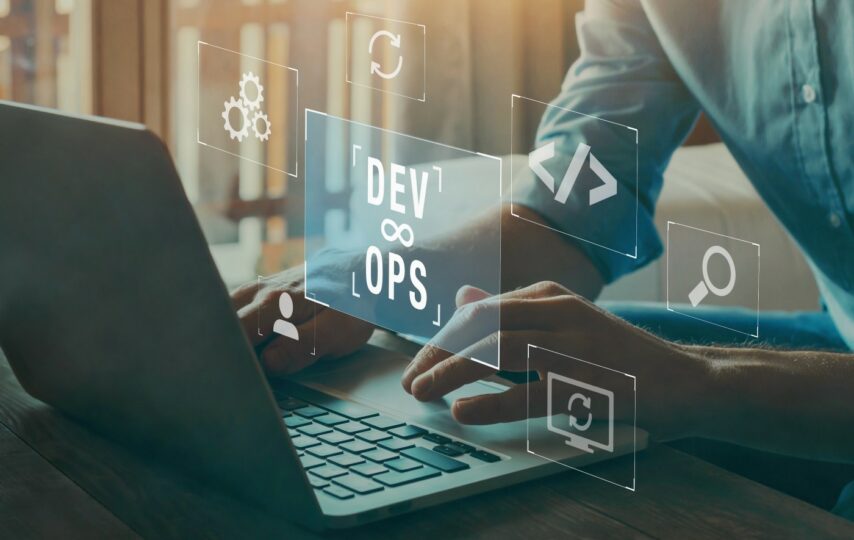Every organization has transformed into a software company in these times of digitization. The popularity of the DevOps approach is growing along with the popularity of cloud-native solutions like Oxeye. The year 2022 has seen a sharp rise in interest in areas like automation, AI/ML, security, etc. So, now it is our responsibility to monitor how DevOps practices evolve so that we can determine where to focus in the upcoming year.
Moreover, according to a report by Research and Markets, the global DevOps market would expand at a CAGR of 23.08% and is expected to reach USD 20.53 billion.
Seeing the figure, it is undeniable that DevOps’ involvement in digital transformation will inevitably lead to revolutionary changes across different industries.
In fact, adopting open communication, transparency, enhanced customer experience, higher quality, and on-time delivery are all part of the DevOps transition. These advantages highlight the need for businesses to use DevOps services to promote better communication, cooperation, visibility, transparency, and integration between DevOps teams.
Furthermore, DevOps is also becoming a fascinating field today and in the future due to constant change, new trends, and practices.
If you’ve landed on this page, I’m pretty sure you are interested in knowing more about the DevOps approach. And I promise not to disappoint you in any way. So, in this blog, I’ll enlist the top DevOps trends you should definitely keep an eye on in 2023.
But here’s the deal, to know about these trends, you need to be with me till the end.
Let’s start!
1.Kubernetes
K8, which refers to Kubernetes, is a commonly used abbreviation for an open-source platform that helps manage workload and containerized services. Developers can scale up or down on the resources, thanks to the autonomous and continuous container-based integration it offers for integration. This is one of the main reasons it will emerge as one of the top DevOps trends in 2023.
In order to adhere to best DevOps practices and industry standards, Kubernetes also supports cross-functional collaboration and ensures minimal deployment downtime.
Let’s understand it with an example of Nordstrom Inc., an American luxury department store with its headquarters in Seattle. Like any other eCommerce outlet, speed, agility, and an incredible client experience are essential to the company’s guiding principles. In order to accomplish a complete DevOps transformation, implementation of consistent integration, and deployment of pipelines, they started using Kubernetes. As a result, there was a drastic modification in operational efficiency.
2.DevSecOps
DevSecOps stands for development, security, and operations. Software development is a standard practice to incorporate security components until the developed solution is unsuccessful. DevSecOps is evolved from DevOps. Therefore, switching to DevSecOps will pick up steam in the future.
Development teams can address some of the most crucial security issues and vulnerabilities of the moment at DevOps speed because DevSecOps integrate security into the CI/CD pipeline.
Enterprises utilize the DevSecOps lifecycle to improve it further because security is one of the most critical issues in the digital age. Companies can use DevSecOps to streamline governance and observability.
3.Low Code Application
DevOps accelerates the total life expectancy of app development. Similarly, low code platforms help further to extend the advantages of DevOps and agile approaches. With the help of the DevOps approach, businesses prefer low code development to create and deploy apps quickly.
Moreover, with no added challenges, low-code app development speeds up the whole process. This accounts for better productivity for businesses that switch to low-code platforms.
Any organization can gain a competitive edge in the dynamic and challenging software industry thanks to the agility that low code unlocks. IT operations and software development are combined in low-code DevOps, which shortens the development lifecycle.
4.Infrastructure as a Code
One of the critical practices in DevOps services are infrastructure as a code (IAC). This modern trend makes it more seamless to handle, control, and provide the infrastructure through automation than a manual process. Applying continuous monitoring, version
control, and virtualization test to the source code that governs the development and management of your infrastructure is an essential DevOps best practice.
Software development and infrastructure teams adopt infrastructure as code DevOps practices as it helps these teams to work together more closely. When you implement infrastructure as code and make it part of your organization’s software lifecycle, stakeholders already have a common language and standards they are familiar with. This shared knowledge, which is crucial to DevOps, makes it easier and simpler to communicate with one another.
5.Realm of AI
AI-driven DevOps will be the way of the future. Since humans cannot handle the enormous volumes of data and computation needed in daily operations, artificial intelligence will replace humans. It will become a prime tool for analysis and computing, transforming how teams design, develop, deploy, and manage applications.
You can combine software with AI to improve its functionality. While utilizing AI, DevOps teams can more efficiently code, test, release, and maintain software. When implementing AI, teams can improve automation, recognize problems as they arise and solve them promptly, and collaborate more effectively.
6.Chaos Engineering
Competition is increasing daily, and every company needs maximum availability for its goods and services. Maintaining order and consistency throughout the day is not simply an SRE’s responsibility; firms increasingly use chaos engineering methodology to evaluate their systems, services, and goods.
Chaos engineering is more than just bug hunting and bug fixing. Another essential aspect is understanding how your systems and apps behave under challenging circumstances. You can find out how your systems and apps respond in extreme and unexpected scenarios better by using chaos engineering to assess the soundness of your applications and systems. A chaotic environment is one in which events take place at unpredictable times and locations.
Therefore, it is impossible to predict chaos. Due to uncertainty, analyzing how a system will respond to specific entries is also confusing. I can ensure our systems are more reliable and resilient if we design them while keeping this in mind.
7.GitOps Gains Momentum
GitOps is a cutting-edge DevOps technique that is revolutionizing the software development industry. It combines two well-known technologies, Git and Kubernetes, and is gaining immense popularity because it makes the DevOps process more efficient.
GitOps offers a method for more automated, reliable, and secure management of app deployments and upgrades. It intended to make communication between the operations, developers, and other stakeholders simpler, quicker, and more consistent. DevOps engineers prefer GitOps because it streamlines the whole DevOps lifecycle – from development to test to production – by automating every step.
GitOps is quickly replacing traditional DevOps due to its capacity to save manual work, enhance reliability and security, and boost productivity.
8.Multi-Cloud Deployments
Multi-cloud deployment is the best approach gaining popularity in the tech industry. You may grow your digital infrastructure, cut expenses, and improve operational efficiency with multi-cloud deployments. You can deploy services and applications across different cloud providers in a cloud-computing architecture known as multi-cloud deployment.
This implies that you can host your services and apps using the capabilities of numerous cloud providers rather than depending solely on one.
Multi-cloud deployments’ access to various services and platforms is the main benefit. Businesses can use this strategy to guarantee they take advantage of the finest services available from each cloud provider. This approach also ensures that the cloud providers’ services are constantly up and accessible, minimizing the likelihood that your apps will experience downtime.
The Ideal Fit!
So, have you been following these DevOps trends? Okay, let me ask you a better question – what DevOps trends will you utilize in 2023 to boost your development productivity and efficiency?
Adopting new trends can be challenging as teams within an organization prepare budgets and rearrange processes and priorities to ensure the new year gets off to a smooth start (and stays that way). However, by utilizing good DevOps services, tools, and techniques, you can experience the following:
- Improve scalability and extensibility
- Faster and more accurate product development
- Time and resource saving via automation tools
- And many more
All in all, DevOps is likely to have a thrilling year!
Willing to transform your company by deploying the efficiency of current DevOps trends? However, unsure of how to proceed.
I have a fundamental yet straightforward solution to this confusion. You can hire DevOps engineers. With the help of best-in-class DevOps engineers, you can experience robust DevOps development services that empower teams and businesses with rapid app onboarding. By preserving quality, they also guarantee on-time delivery.
That’s all from my end. Happy Learning!







